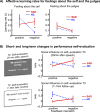Social anxiety is characterized by biased learning about performance and the self
- PMID: 28358557
- PMCID: PMC5623172
- DOI: 10.1037/emo0000296
Social anxiety is characterized by biased learning about performance and the self
Abstract
People learn about their self from social information, and recent work suggests that healthy adults show a positive bias for learning self-related information. In contrast, social anxiety disorder (SAD) is characterized by a negative view of the self, yet what causes and maintains this negative self-view is not well understood. Here the authors use a novel experimental paradigm and computational model to test the hypothesis that biased social learning regarding self-evaluation and self-feelings represents a core feature that distinguishes adults with SAD from healthy controls. Twenty-one adults with SAD and 35 healthy controls (HCs) performed a speech in front of 3 judges. They subsequently evaluated themselves and received performance feedback from the judges and then rated how they felt about themselves and the judges. Affective updating (i.e., change in feelings about the self over time, in response to feedback from the judges) was modeled using an adapted Rescorla-Wagner learning model. HCs demonstrated a positivity bias in affective updating, which was absent in SAD. Further, self-performance ratings revealed group differences in learning from positive feedback-a difference that endured at an average of 1 year follow up. These findings demonstrate the presence and long-term endurance of positively biased social learning about the self among healthy adults, a bias that is absent or reversed among socially anxious adults. (PsycINFO Database Record
(c) 2017 APA, all rights reserved).
Figures


Similar articles
-
The effects of positive interpretation bias on cognitive reappraisal and social performance: Implications for social anxiety disorder.Behav Res Ther. 2020 Aug;131:103651. doi: 10.1016/j.brat.2020.103651. Epub 2020 May 22. Behav Res Ther. 2020. PMID: 32504886
-
Out of my league: Appraisals of anxiety and confidence in others by individuals with and without social anxiety disorder.J Anxiety Disord. 2018 Jun;57:76-83. doi: 10.1016/j.janxdis.2018.05.005. Epub 2018 May 16. J Anxiety Disord. 2018. PMID: 29858095
-
Combined Audience and Video Feedback With Cognitive Review Improves State Anxiety and Self-Perceptions During Speech Tasks in Socially Anxious Individuals.Behav Ther. 2018 Mar;49(2):165-179. doi: 10.1016/j.beth.2017.11.006. Epub 2017 Dec 5. Behav Ther. 2018. PMID: 29530257
-
Cognitive-behavioral models of social anxiety disorder.Psychiatr Clin North Am. 2001 Dec;24(4):753-71. doi: 10.1016/s0193-953x(05)70261-6. Psychiatr Clin North Am. 2001. PMID: 11723631 Review.
-
Safety Behaviors in Adults With Social Anxiety: Review and Future Directions.Behav Ther. 2016 Sep;47(5):675-687. doi: 10.1016/j.beth.2015.11.005. Epub 2015 Dec 21. Behav Ther. 2016. PMID: 27816080 Review.
Cited by
-
Behavioural and neural evidence for self-reinforcing expectancy effects on pain.Nat Hum Behav. 2018 Nov;2(11):838-855. doi: 10.1038/s41562-018-0455-8. Epub 2018 Oct 29. Nat Hum Behav. 2018. PMID: 31558818 Free PMC article.
-
Changes in Learning From Social Feedback After Web-Based Interpretation Bias Modification: Secondary Analysis of a Digital Mental Health Intervention Among Individuals With High Social Anxiety Symptoms.JMIR Form Res. 2023 Aug 9;7:e44888. doi: 10.2196/44888. JMIR Form Res. 2023. PMID: 37556186 Free PMC article.
-
Informing the treatment of social anxiety disorder with computational and neuroimaging data.Psychoradiology. 2024 May 3;4:kkae010. doi: 10.1093/psyrad/kkae010. eCollection 2024. Psychoradiology. 2024. PMID: 38841558 Free PMC article. No abstract available.
-
Hooking the Self Onto the Past: How Positive Autobiographical Memory Retrieval Benefits People With Social Anxiety.Clin Psychol Sci. 2024 Sep;12(5):882-902. doi: 10.1177/21677026231195792. Epub 2023 Nov 15. Clin Psychol Sci. 2024. PMID: 39309219 Free PMC article.
-
Change, stability, and instability in the Pavlovian guidance of behaviour from adolescence to young adulthood.PLoS Comput Biol. 2018 Dec 31;14(12):e1006679. doi: 10.1371/journal.pcbi.1006679. eCollection 2018 Dec. PLoS Comput Biol. 2018. PMID: 30596638 Free PMC article.
References
-
- Alden LE, Taylor CT, Mellings TMJB, Laposa JM. Social anxiety and the interpretation of positive social events. Journal of Anxiety Disorders. 2008;22(4):577–590. - PubMed
-
- Alden LE, Trew JL. If it makes you happy: Engaging in kind acts increases positive affect in socially anxious individuals. Emotion. 2013;13(1):64. - PubMed
MeSH terms
Grants and funding
LinkOut - more resources
Full Text Sources
Other Literature Sources

